As an Amazon Associate I earn from qualifying purchases.
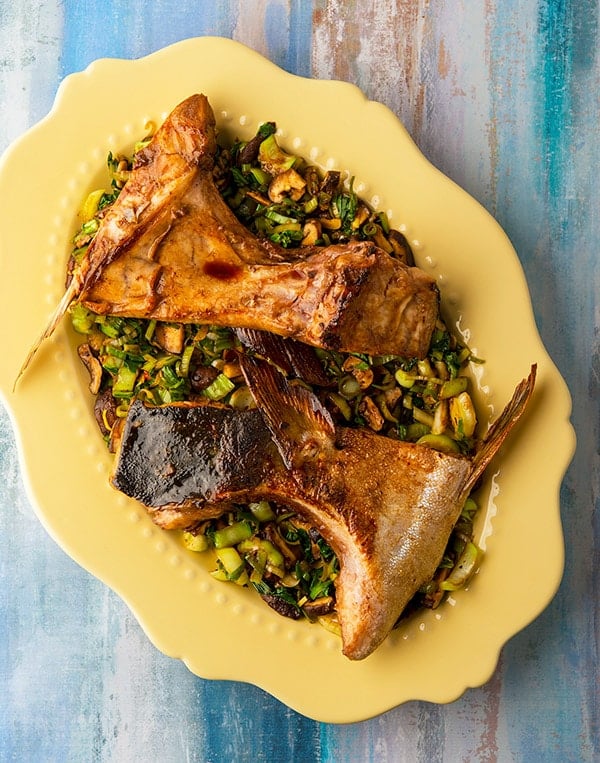
I remember the first time I had hamachi kama. Obviously, it was at a sushi restaurant, because, well, that’s pretty much the only place you can find grilled yellowtail collar, which is what hamachi kama happens to be.
It was a little sushi place in Sayville, Long Island, and I had no certain idea what I was ordering. I thought it was tuna at the time — there are no yellowtail in the North Atlantic, but there are certainly yellowfin tuna. And I knew what a fish collar was, having eaten them off the striped bass I’d been catching.
I wasn’t prepared for the experience. Striped bass collars are nice, but nothing like the fatty, meaty, charred goodness that hamachi kama was! Not until I moved out West and started grilling salmon collars was I able to sort of replicate that meal.
I still order hamachi kama at restaurants, but, since yellowtail is a Southern California fish, by and large, making it at home was out of the question. Until, finally, after several attempts, I caught a nice yellowtail aboard the Pacific Mistress out of Dana Point.
As nice as the guys are aboard that boat, which I can highly recommend, no one touches my fish — especially since I wanted the belly and collar of this yellowtail most of all, and, well, not many people ask for it aboard fishing charters so they didn’t have a ton of experience with those cuts. Crazy, eh?
Now keep in mind that the hamachi kama you order in a restaurant won’t ever be as glorious as the one you see in the pictures, largely because they never serve the collars off such large yellowtail. Or at least I’ve never seen one this big.
Do you need to have yellowtail to make hamachi kama? Kinda, yeah. That’s what a hamachi is. That said, really good substitutes would be the collars off almaco or amberjacks, small tuna like blackfin or skipjack, as well as wahoo or king mackerel. You want a fish with some fat. (If you have salmon, click that link above for what to do with them.)
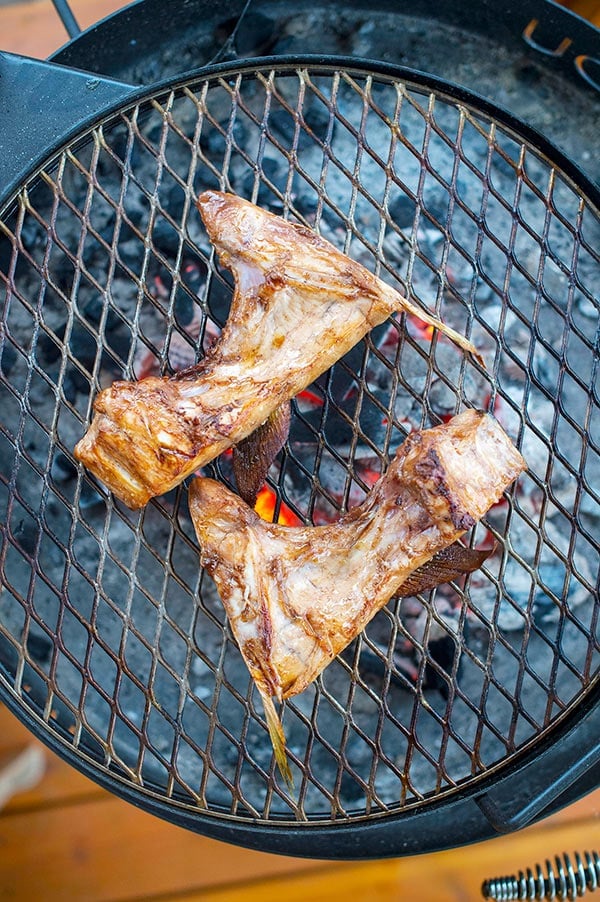
Do you have to grill your collars? I’d say yes, but if you can’t, you can broil them. Just keep an eye on the collars so they only burn a little.
You will want to start making hamachi kama a day in advance, so you can have the collars well marinated. I generally use a simple ponzu marinade, which is basically a soy-citrus mixture.
Grill your collars over high heat, painting them with sesame oil, until they are cooked through and a little charred. Generally this is pick-it-up-and-eat-it food, but you can pick at hamachi kama with chopsticks or a fork.
Serve with a salad, steamed rice, and plenty of beer.
Hamachi Kama
Ingredients
MARINADE
- 1/3 cup lemon juice
- 1/3 cup lime juice
- 1/3 cup orange juice
- 1 cup soy sauce
- 1/4 cup mirin or other rice wine
FISH
- 4 yellowtail collars (or substitute, see above)
- Sesame oil
Instructions
- Mix the marinade ingredients together and put them, along with the yellowtail collars, into a heavy plastic bag or lidded container. Marinate overnight or up to 1 day. If the collars are not submerged, turn them periodically so they get good contact with the marinade.
- The next day, pour the marinade into a small pot and bring it to a boil. Reduce it by half, and set it aside.
- Pat the collars dry with paper towels and coat with a film of sesame oil. Get your grill nice and hot, and clean the grates.
- Grill your collars over high heat, basting with the reduced marinade, for about 10 to 20 minutes, depending on how large your collars are and how hot your fire is. You want them fully cooked and a little charred. Serve with steamed rice and a salad.
Notes
Nutrition
Nutrition information is automatically calculated, so should only be used as an approximation.

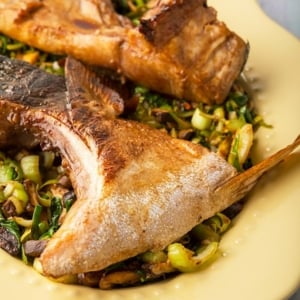
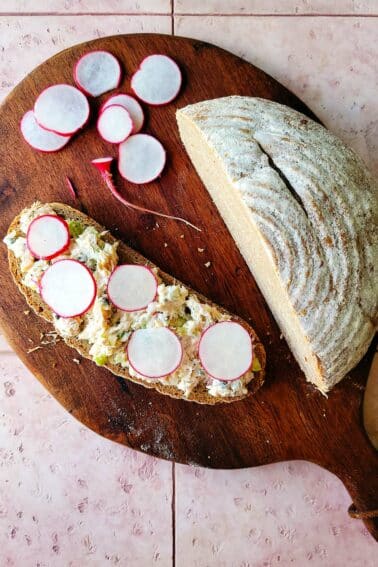
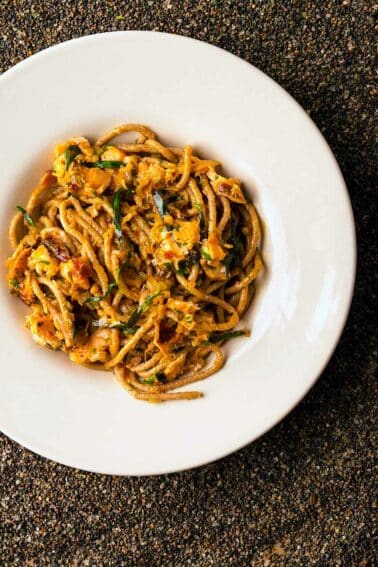
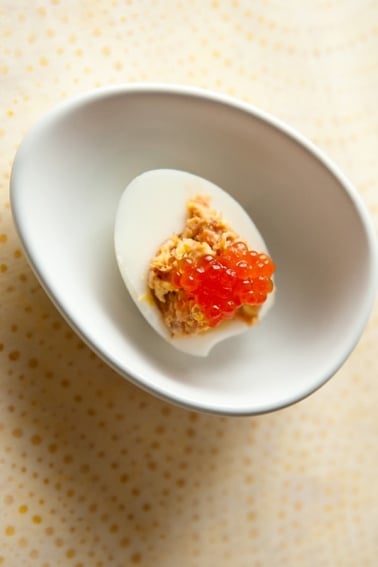
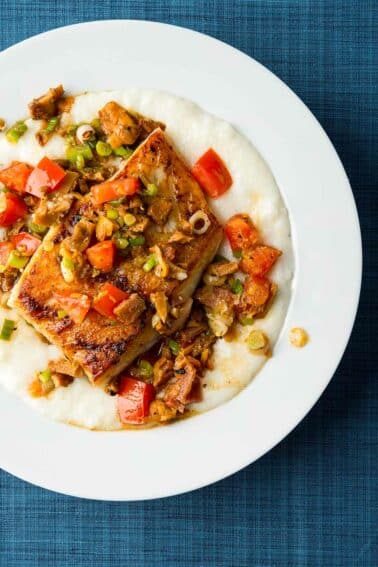
It’s unbelievable how something so simple can be so delicious. Where has this been all my life? Definitely going to happen every time I can get collars.
“Now keep in mind that the hamachi kama you order in a restaurant won’t ever be as glorious as the one you see in the pictures, largely because they never serve the collars off such large yellowtail. Or at least I’ve never seen one this big.”
Yep, because then it would be “Buri Kama” as yellowtail have different names depending on the region you’re in and their size. Buri are the biggest, then Hamachi and Tsubasu (if you’re in the western half of Japan) for medium and smaller ones respectively.
Saboten: I did not know that, thanks!
Thanks so much! My son just dropped off the collars, belly and a nice yellow tail fillet he caught yesterday. I think I’ll marinate it all in this sauce and grill it on my charcoal grill tomorrow. Yum!
What kind of grill is that in the third photo?
Jon: It’s from Kudu Grills. They are based in Georgia.
Thanks for this post, Hank. Very similar to the collar recipe I use with on nuance… reducing the marinade and brushing it on while grilling! That was and epic addition. Just did it last night with a yellow I shot 2 days ago. It was great. Thanks for bumping my collar game to the next level!
You brought me back to the first time I had grilled yellowtail collar. It was a transformative experience: that mind-blowing combination of simplicity of preparation with the complexity of flavours. I know what I’m doing for the next barbecue… Thanks for the reminder.
King salmon collars rule! I live in Alaska and relish the fatty belly’s and collars. I use cocoa aminos in my marinade for an unctuous subtle flavor.
Nothing compares to the Hamachi Kama, I’ve had Salmon Kama it was not even close to as tasty. The fat content in the Hamachi Kama makes it perfect for the grill.
Jacob: I agree that hamachi kama is better than salmon kama, but I’ve done it with some king salmon that were even fattier than hamachi!
Hey, for those in the East Bay area, Berkeley Bowl’s excellent fish counter carries fresh hamachi kama. Yum!
Hank, next time you’re in Vegas, check out a place called Ichizu. Unconventional takes on Japanese food, but their hamachi kama is very old-school, and if I remember correctly, quite large.
Thanks for this recipe. I’ll definitely try it sometime. Because of you I have learned of the glory of fish collars, and used to make the salmon collar recipe often when I lived in the Pacific Northwest.
I read this article with my morning pot of coffee and want that dish right now. I can find cheeks, belly and collars of different fish at a Korean market in Baltimore. Time to grill something other than venison.
This works really well for halibut too!
Another trick is to split a halibut head in half and pan fry in half inch of oil until brown and crispy. Just kosher salt, grab a beer and pick away at the best halibut checharones ever!
This recipe is different than your other one which we have enjoyed for years.The marinade for that one is soy,mirin,sesame oil for no longer than 4 hours,it`s great and we make the Ponzu is pretty much the same.We get our wild salmon collars from a vendor at Davis Farmers Market since fishing is no longer doable for me.
Work with swordfish collars? Available east coast in Gloucester, MA. tysm for your posts
Sandra: Yes, and tuna, too.
Doesn’t all that citrus acid in the marinade cook the fish, especially overnight?
James: Sort of, but remember that acid doesn’t actually cook fish. It just gives it that look.
Nice! I’m looking forward to trying this one. I just made your barbacoa recipe and it was excellent.